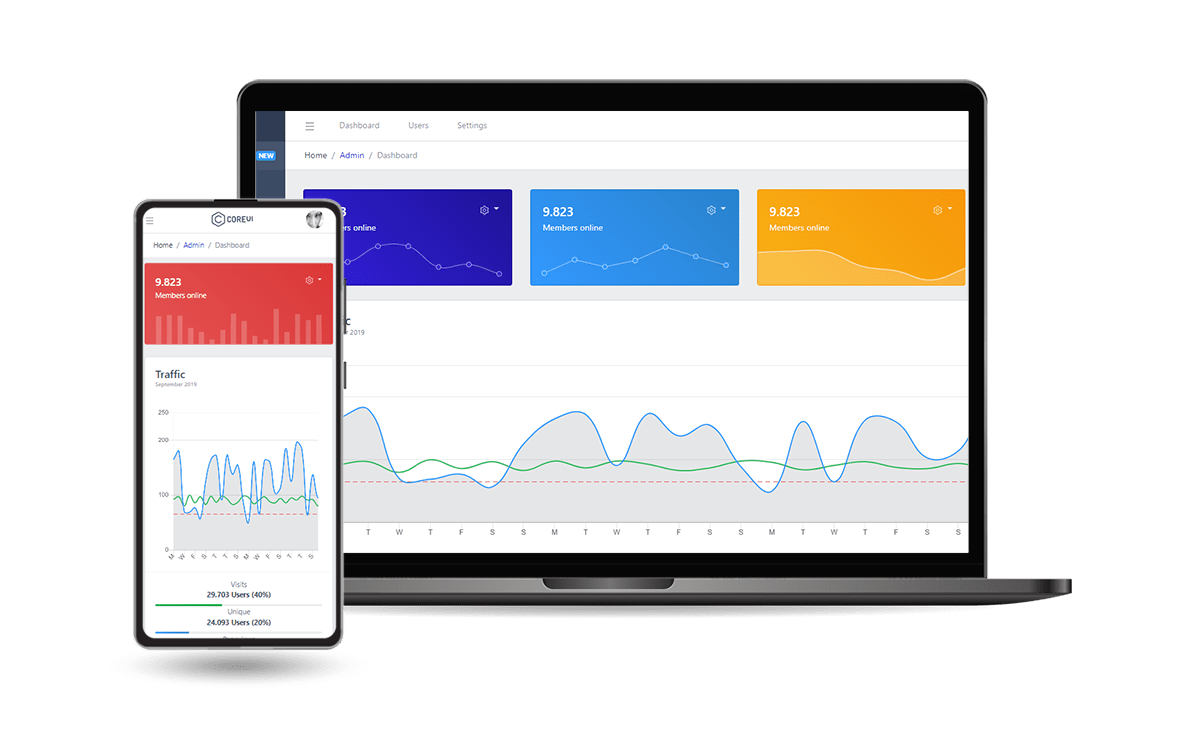CoreUI#
Django CoreUI is an open-source starter built on top of the CoreUI Design, a popular admin dashboard template.
👉 Django CoreUI - Product Page (contains download link)
👉 Django CoreUI - LIVE Demo
👉 Get Support via Email and Discord
👉 New to App-Generator? Sign IN with GitHub or Generate Web Apps in no time (free service).
Features#
Simple, Easy-to-Extend codebase
CoreUI Design Integration
Bootstrap CSS Styling
Session-based Authentication
DB Persistence: SQLite (default), can be used with MySql, PgSql
Docker
CI/CD integration for Render

Prerequisites#
A few tools need to be installed in the system to use the starter efficiently:
Download Source Code#
The product can be downloaded from the official product page or directly from GitHub (public repository)
git clone https://github.com/app-generator/django-coreui.git
cd django-coreui
Once the source code is unzipped, the next step is to start it and use provided features.
Start in Docker#
The fastest way to start the product is to execute the Docker set up:
docker-compose up --build
If Docker is properly installed in the system, you can visit the browser at http://localhost:5085. Product should be up and running.
Codebase#
The project is coded using a simple and intuitive structure presented below:
< Project ROOT >
|
|
|-- core/
| |-- settings.py # Project Configuration
| |-- urls.py # Project Routing
|
|-- home/
| |-- views.py # APP Views
| |-- urls.py # APP Routing
| |-- models.py # APP Models
| |-- tests.py # Tests
| |-- templates/ # Theme Customisation
| |-- pages
|
|-- requirements.txt # Project Dependencies
|
|-- env.sample # ENV Configuration (default values)
|-- manage.py # Start the app - Django default start script
Manual Build#
It’s best to use a Python Virtual Environment for installing the project dependencies. You can use the following code to create the virtual environment
virtualenv env
To activate the environment execute env\Scripts\activate.bat for Windows or source env/bin/activate on Linux-based operating systems.
Having the VENV active, we can proceed and install the project dependencies:
pip install -r requirements.txt
Environment#
The starter loads the environment variables from .env file. Here are the critical ones:
DEBUG: set by default to False (development mode)
SECRET_KEY: a random value used by Django to secure sensitive information like passwords and cookie information
- Database Credentials: DB_ENGINE, DB_USERNAME, DB_PASS, DB_HOST, DB_PORT, DB_NAME
if detected, the database is switched automatically from the default SQLite to the specified DBMS
Setting up the Database#
By default, the application uses SQLite for persistence. In order to use MySql / PostgreSQL, you’ll need to install the Python driver(s):
pip install mysqlclient # for MySql
# OR
pip install psycopg2 # for PostgreSQL
To connect the application with the database, you’ll need to fill in the credentials int the .env file and run the migrations.
DB_ENGINE=mysql
# OR
DB_ENGINE=postgresql
# DB credentials below
DB_HOST=localhost
DB_NAME=<DB_NAME_HERE>
DB_USERNAME=<DB_USER_HERE>
DB_PASS=<DB_PASS_HERE>
DB_PORT=3306
Use the following commands to set up the database:
python manage.py makemigrations
python manage.py migrate
Running the project#
The following command starts the project using Django development server:
python manage.py runserver # Starts on default PORT 8000
python manage.py runserver 8999 # Starts on PORT 8999 (custom port)
By default Django starts on port 8000 but this can be easily changed by adding the PORT number as argument. At this point, the app runs at http://127.0.0.1:8000/

Create Users#
By default, the app redirects guest users to authenticate. In order to access the private pages, follow this set up:
Start the app
Access the registration page and create a new user: - http://127.0.0.1:8000/register/
Access the sign in page and authenticate - http://127.0.0.1:8000/login/
The superusers can be easily created via the CLI:
python manage.py createsuperuser
Add Features with our Django Generator (free service)#
Using the sevice, developers can customize:
Select the preferred design
Design Database: edit models and fields
Add fields to Extended user model
Enable OAuth for GitHub and Google (soon)
Add Celery (async tasks)
Enable Dynamic API Module
Docker Scripts
CI/Cd Scripts for Render
The generated Django project is available as a ZIP Archive and also uploaded to GitHub.
Links#
👉 New to App-Generator? Join our 10k+ Community using GitHub One-Click SignIN.
👉 Download products and start fast a new project
👉 Bootstrap your startUp, MVP or Legacy project with a custom development sprint
